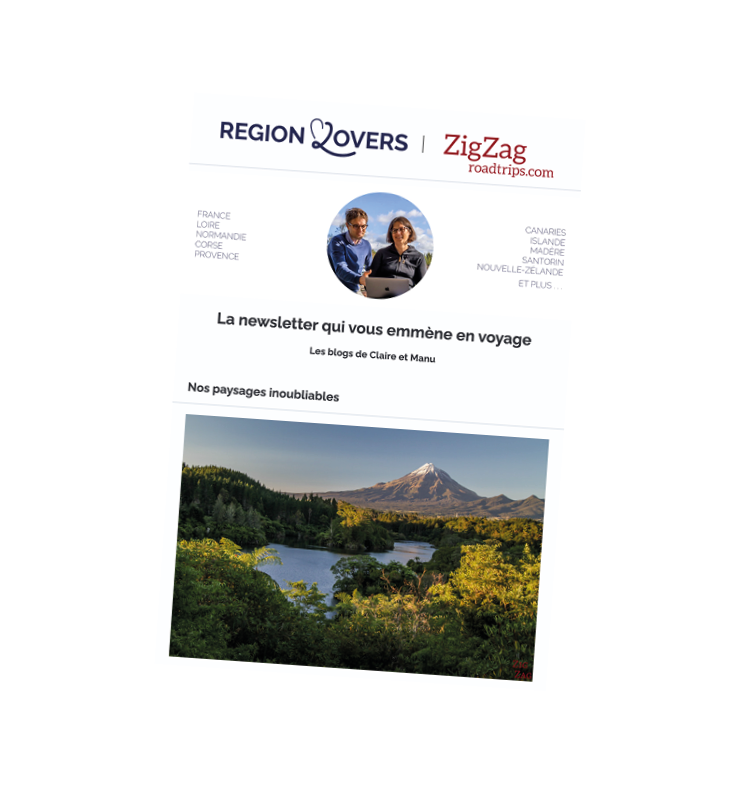Corsica’s 2nd largest city and capital of Haute-Corse, Bastia is a city of character. With its colorful facades and winding streets, you’ll be seduced by its beauty, worthy of the most famous Italian cities. In fact, Bastia was developed by the Genoese as early as the 14th century, around two districts: Terra Vecchia (the old port district) and Terra Nova (the citadel district).
In this article, we’ll guide you on your future visit to the city with 12 ideas of must-see places in Bastia. Excursions, places of worship, beaches and local produce: we give you all our practical tips and advice on what to do in Bastia. Enjoy your visit!
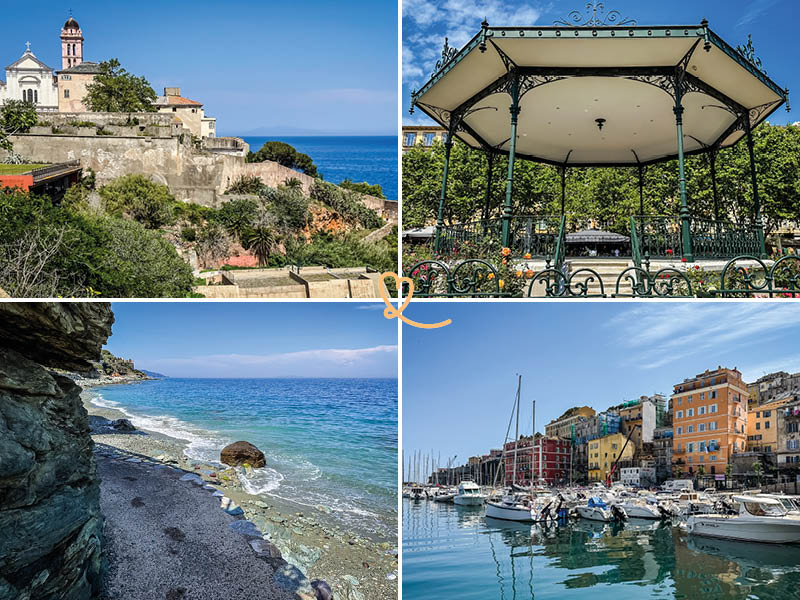
This opinion is completely independent, based on our experiences. We visited the area anonymously, making our own choices, and paying all our bills in full.
The best things to do in Bastia
Before we reveal all our ideas for things to do and see in Bastia, here’s a short video to inspire you!
1. Stroll through the citadel district
Why visit the citadel district?

The citadel district is a must-see in Bastia! This is where you’ll find the fortifications built by the Genoese in the 14th century. We found it very pleasant to stroll through its winding streets. This part of the town also offers a superb view of the Bay of Bastia! The citadel is built on a rocky promontory overlooking the old port. On a clear day, you can even see the Italian island of Isola d’Elba.
What you will see

Take a stroll around the citadel district, and you’ll see some of Bastia’s major monuments, including the Palais des Gouverneurs and the Oratoire Sainte-Croix. We enjoyed discovering Bastia’s residences, such as La Casetta, a former Genoese town hall, or the more unusual U Cimbalu. We were astounded by this residence and its trompe-l’œil paintings, created in the 20th century and depicting emblematic Corsican figures.
Last but not least, this area offers some very fine views:
- From the port: down the “Mantinum” stairs from the Governors’ Palace.
- Overlooking the sea: from the Aldilonda pedestrian walkway below.
How much time to allow
To visit the citadel district, allow at least 1 hour. This part of town is relatively small and easy to find your way around.

More information on the citadel district
We advise you to take good walking shoes to visit this area. The climb to the citadel is steep, but the ground is not difficult.
Access to the citadel is possible for people with reduced mobility:
- from the promenades below.
- by elevator on Quai Albert Gillio, level with the Mantinum.
Although parking is forbidden in most of the district, you can park in the underground parking lot at the citadel (chargeable, accessible by elevator, with electric recharging points). Next to the parking lot, you’ll undoubtedly see Bastia’s little tourist train, which stops here for the departure of guided walking tours of the district.

OUR TIPS FOR RENTING A CAR IN Corsica
- Compare prices on our preferred platform: DiscoverCars – one of the best rated sites.
- Choose a car that is powerful enough (the roads are steep) but compact (some passages are narrow).
- Think of thecomplete insurance (some roads are tortuous and narrow).
- There is a lot of demand, book it early.
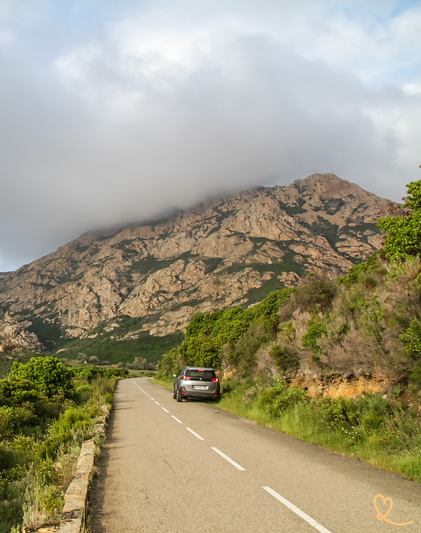
2. Visit Sainte-Marie Cathedral
Why visit Sainte-Marie Cathedral?

Located in the heart of the citadel district, Sainte-Marie Cathedral dates back to the 17th century. Listed as a historical monument, it contains numerous works of art. Its pavement, made of Italian marble (Carrara and Levanto) and Corsican marble (Corte, Bevinco), made a lasting impression on us. But the cathedral is best known for its solid silver processional statue of the Virgin Mary, which we found quite impressive!
What you will see

You can admire the cathedral’s facade, which has been altered over the centuries. Inside, you’ll be seduced by the profusion of ornaments and materials (gold, gilded stucco, marble…) typical of the Baroque style. They are seated in the very wide nave, on the barrel vault decorated with a 19th-century painting, and in the spacious choir, housing a statue of the Virgin Mary almost 2.60 m high.
We were also impressed by the 19th-century organs from Bergamo’s Maison Serassi. Leonoro dell’Aquila’s 16th-century wooden altarpiece of the Assumption is also a must-see.
Finally, can you spot the seven bishops’ hats buried in the cathedral crypt?
How much time to allow
Allow 30 minutes to visit the cathedral and admire all it has to offer. Please note that there are no historical explanations to accompany you on your visit.

More information on Sainte-Marie Cathedral
St. Mary’s Cathedral is open daily from 8am to 12pm and from 2pm to 5pm, except on Sundays and during religious services.
The floor is flat and smooth, with no difficulties.
The access and the visit are free.
Please note that the cathedral is not lit. To illuminate both the entire cathedral and the showcase of the solid silver Madonna, you need to go to the coin slot to the left of the main entrance. You can only insert 50-cent coins (for 1min30 of illumination) or €1 coins (3min of illumination).
Read our article on Sainte-Marie Cathedral to help you prepare for your visit.
3. Visit the Palace of the Governors
Why visit the Palais des Gouverneurs?

You won’t want to miss the Palais des Gouverneurs! We were stunned by its facade, which unfurls masterfully across the Place du Donjon. The original Genoese fortified construction was called “la Bastia” and gave its name to the town. The residence of Genoese power until the 18th century, it soon became an army barracks.
Partly destroyed during the Second World War, it was rebuilt in 2008 in a contemporary style, adapted to its new functions as a museum of art and history. The only museum in Bastia, it is listed as a historic monument. We advise you to visit it: it will allow you to enter the historic citadel.
What you will see

The Palais des Gouverneurs, or Musée de Bastia, offers visitors the chance to discover the history of Bastia and, to a lesser extent, the citadel. The chronological tour extends from ancient Corsica to the 18th century. We learned more about Bastia’s urbanization, Italian influence, 18th-century wars, Frenchization, religious art and the industrial revolution.
The fine and decorative arts collections, together with multimedia displays, provide a clearer picture of Bastia’s place over the centuries, both in Corsica and more widely in Europe. The tour ends with a visit to the museum’s gardens, offering a beautiful view of the port.
How much time to allow
To get the most out of your visit, allow 2 hours.

More information on the Palais des Gouverneurs
In addition to its permanent collections, the museum sometimes organizes temporary exhibitions. We advise you to check the program on the official website.
Opening hours:
- May to September: 10 a.m. to 6.30 p.m. Closed Mondays in May, June and September and open daily in July and August.
- October to April: 9am to 12pm and 2pm to 5pm. Closed Sundays and Mondays.
- Closed on November 1st, November 11th, May 1st, May 8th and during the Christmas school vacations.
Tickets cost €5 and can be purchased on site.
The museum is accessible to people with reduced mobility, who benefit from an adapted itinerary. You can bring your children with you, and a baby changing facility is available in the toilets.
You can also get there by public transport. A free shuttle service is available from the train station. By bus (lines 2, 3, A and B), get off at the “Cours Docteur Favale” or “Place Vincetti” stop.
For parking, go to the citadel parking lot, Place Vincetti, which closes at 10.30pm.
To organize your visit to the Palais des Gouverneurs, read our dedicated article.
WHERE TO STAY IN Bastia
To enjoy the charm of this colourful, vibrant city, it’s best to spend one or more nights here! Our suggestions:
Option 1: in the lower center
We recommend..:
- Hôtel des Gouverneurs, in the citadel – see prices, photos and availability
- Hotel Monsieur Miot and its beautiful decor – see prices, photos and availability

Option 2: up-center
We recommend..:
- Hotel Le Bastia and its magnificent views of the city and the sea – see prices, photos and availability

Option 3: in the surrounding area
We recommend..:
- Hotel Alivi, north, with beach access – see prices, photos and availability
- Hotel Pineto in the south, along the sandy beach – see prices, photos and availability

See our list of the 10 best hotels in Bastia, with our reviews
4. Stroll through the Romieu garden
Why stroll through the Romieu garden?

The Romieu garden was created in the 19th century, making it Bastia’s first public garden. Its aim was to link the upper and lower towns. The town of Bastia has few green spaces, and this one offers a short, shady stroll with a very interesting view of the harbor lighthouse.
What you will see

The Romieu garden is a rock garden featuring local species such as umbrella pines, and exotic species such as Japanese charcoal and Australian belombra. We were seduced by its wrought-iron staircases, statues and free-standing vases.
At the bottom of the garden, you’ll descend a vast horseshoe-shaped staircase that particularly impressed us. It leads to a small square on the harbor quays, and is decorated with a fountain. This staircase, and to a lesser extent the garden, are emblematic of Bastia. They have been listed on the Inventaire Supplémentaire des Monuments Historiques since 2017.
How much time to allow
Relatively small, it takes 15-20 minutes to fully enjoy the garden and its views.

More information on Jardin Romieu
The Romieu garden has staircases. If you’re heading uphill to reach the citadel, the climb is steep but easier than if you’re taking the road.
Open all year round, Mondays, Tuesdays and Saturdays from 9am to 8pm, and Wednesdays and Fridays from 8am to 11pm.
The visit is free of charge.
USE OUR GUIDE TO PLAN A
DREAM TRIP TO Corsica
All the information you need for your trip:
- 7 maps that make planning easier
- 130+ pre-selected locations
- Practical advice
- + 220 photos to help you choose
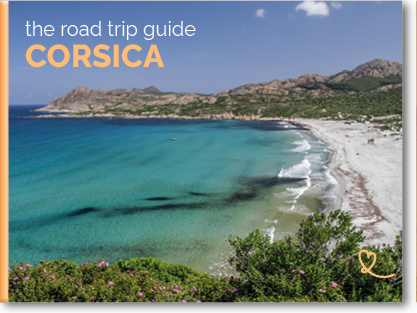
5. Stroll around the old port
Why take a stroll around the Old Port?

A stroll through the old port district is a must if you want to discover Bastia, a maritime city. To get the full picture, head to the end of Dragon Pier, at the foot of the lighthouse. We found the view sublime, with the colorful facades of the buildings and the majestic Église Saint-Jean-Baptiste standing out impressively from the rest of the city.
Afterwards, we took advantage of the lively quayside restaurants. We soon made our way back to the heart of the city via the district’s pretty alleyways.
What you will see

In addition to the Church of St. John and the boats and restaurants of the port, you’ll stroll through colorful streets revealing ancient Bastia palaces such as the Palais Cardi or the Castagnola house. In rue Napoléon, boulevard Paoli and rue Campinchini, you’ll find a wide range of stores.
During our walk, we passed through the market square. We recommend a visit here, right next to the Église Saint-Jean-Baptiste, a small square with a beautiful contemporary fountain.
How much time to allow
Allow at least 2 hours for a leisurely stroll through the old port, its streets and alleys.

More information on the Old Port district
Terra Vecchia, or the old port district, is the heart of Bastia. The alleyways are sometimes narrow and accessible by stairs, but the main streets are not difficult.
While the area is quiet, especially on Mondays, the market square is bustling with a local market every Saturday and Sunday morning. During the festive season, you’ll find a Christmas market here, and in summer, bands often perform in the square, which is invaded by restaurant terraces.
6. Visit Saint-Jean-Baptiste Church
Why visit Saint-Jean-Baptiste Church?

Standing proudly above the port of Bastia, the Church of Saint-Jean-Baptiste is a must-see! Probably more famous than the cathedral in the citadel, we really enjoyed this church, which is as beautiful on the outside as it is on the inside. Listed as a historic monument, it is the largest church in Corsica!
What you will see

The Church of St. John the Baptist is in the Genoese Baroque style. Here you’ll find a sumptuous 18th-century pulpit, the most valuable in Corsica. Created by Genoese sculptors, it is made of white marble, inlaid with other types of marble, such as Siena yellow or Polcevera green.
We found the organ loft impressive, evoking the stern of a Baroque ship. Take a look at the beautiful silver tabernacle on the high altar. Finally, we noticed the side altars adorned with large Baroque paintings by Genoese artists.
How much time to allow
A visit to Saint-Jean-Baptiste Church will take between 20 and 30 minutes.

More information on Saint-Jean-Baptiste Church
The ground is not particularly difficult. A side entrance with a ramp makes the church accessible to people with reduced mobility and baby carriages.
Visits to the building are free of charge. Open Monday to Friday, 8:30am to 6pm, and Saturday, 8:30am to 12pm and 2pm to 6pm, except during religious services.
Find out more in our article dedicated to Saint-Jean-Baptiste Church.
Subscribe to our Newsletter
- Get away from it all with Region Lovers’ beautiful destinations!
- Once a month
- Advertising-free
7. Visit Place Saint-Nicolas
Why visit Place Saint-Nicolas?

Bastia’s nerve center, Place Saint-Nicolas, is where Bastia families and tourists meet. Overlooking the commercial port where the ferries pass by, we found this square, one of the largest in France, very charming. Punctuated by century-old palm trees, it measures around 280m long and 80m wide.
It’s lined with cafés and shops, as well as several events (concerts, flea and textile markets on Sunday mornings, an ice rink for the festive season…), making it an important part of life in Bastia.
What you will see

Several buildings dot the Place Saint-Nicolas. We admired the monumental statue of Napoleon I, portrayed as a Jupiter in antique style. This 19th-century monument in Carrara marble is nearly 8m high!
A little further on is a bandstand, surrounded by flowerbeds. To keep children occupied, a merry-go-round is located on the periphery of the square. Finally, don’t hesitate to leave the square to take a closer look at the Casabianca submarine. This enabled us to find out a little more about the liberation of Corsica, occupied by Italy during the Second World War.
How much time to allow
Allow 15-20 minutes to explore Place Saint-Nicolas.

More information on Place Saint-Nicolas
Place Saint-Nicolas presents no particular difficulties.
As far as transport is concerned, there’s a cab rank and paid parking spaces specifically for motorcycles. Underground parking is available at a charge, and can be accessed from a number of entrances on the square itself.
The square is also served by bus line 3 (Falata di a Pia and L’Altu d’A Pia stops).
This is also where you’ll find the tourist office and the tourist train, which departs from the station right in front of it.

8. Taste Corsican products at U Paese
Why and where to try Corsican products?

You can’t leave Bastia or Corsica in general without sampling the local produce! Succulent charcuterie, a wide choice of cheeses (ewe, brocciu…) and terrines, as well as mustards and oils, with maquis herbs or myrtle, you’ll be spoilt for choice. For sweet treats, we recommend you try Corsican honey and the “Nuciola” spread, made with hazelnuts from Cervione!
Many stores sell Corsican products in Bastia. We recommend a visit to the “U Paese” boutique in Rue Napoléon.
What you will see

With its yellow front, you won’t want to miss it! The U Paese store offers top-quality Corsican products: wines, spirits, cheeses, charcuterie, as well as sweet dishes and Corsican condiments, whet our appetites. Here, the friendly staff will let you taste the products before you buy.
Here you’ll find lonzo or vacuum-packed coppa slices: ideal if you don’t have room in your suitcase and don’t want to spend a lot (between €5 and €6 for a dozen slices). Delicatessen is also available in pieces (expect to pay at least €15).
How much time to allow
It will take you 15 to 30min depending on how long you take to make your choice and whether you taste some local Corsican products.

More information
The U Paese store is open every day from 9am to 7pm, except Sundays and Mondays, when it is open from 10am to 6pm.
HOW TO GET TO Corsica

Option 1: by ferry
Departure from France and Italy
- See all ferry options in our article
- Compare schedules, prices and availability directly
Advantage: you can take your car!

Option 2: by plane
Airports in Bastia, to visit the North, Figari to visit the South, or Ajaccio convenient for all Corsica.
Compare flights!
9. Visit Saint-Roch Oratory
Why visit Saint-Roch Oratory?

From Place Saint-Nicolas and Rue Napoléon, the Oratoire Saint-Roch is the first religious building you’ll come across. Once you’ve admired the 19th-century neoclassical façade, we strongly recommend you enter. The origins of this oratory date back to the 16th century! The Saint-Roch brotherhood was then reserved for teenagers from the lower town. This oratory, with its rich Baroque decor, is well worth a visit!
What you’re about to see

Inside, you’ll be amazed by the walls covered in red silk damask and waxed walnut panelling. We were immediately drawn to the high altarpiece, sculpted in the 17th century by Genoese marble-maker Domenico Saporito. It frames a 17th-century painting by Florentine artist Giovanni Bilivert. Saint-Roch can also be seen in a niche in the nave. This time, it’s a polychrome wooden processional statue, recently restored. Don’t forget to check out the sumptuous ceiling decorations before you leave!
How much time to allow
15min will be enough to admire this modest-sized oratory, more if you’re an architecture enthusiast.

More information on Saint-Roch Oratory
The Oratoire Saint-Roch has no special access for people with reduced mobility or baby carriages. The ground is not particularly difficult. Only two low steps lead up to the monument.
The building is open Monday to Friday, 8.30am to 6pm, Saturday 8.30am to 12pm and 2pm to 6pm, and Sunday 8.30am to 1pm, except during religious services.
OUR TIPS FOR RENTING A CAR IN Corsica
- Compare prices on our preferred platform: DiscoverCars – one of the best rated sites.
- Choose a car that is powerful enough (the roads are steep) but compact (some passages are narrow).
- Think of thecomplete insurance (some roads are tortuous and narrow).
- There is a lot of demand, book it early.

10. Visit the Oratory of the Immaculate Conception
Why visit the Oratory of the Immaculate Conception?

Still on rue Napoléon, you’ll come across another oratory, that of the Immaculate Conception. We noticed its pretty facade with a Baroque portal in Carrara marble. Take the time to observe its detailed mouldings before entering!
This 17th-century building is once again inspired by Genoa’s Baroque style. As in the Oratoire Saint-Roch, you’ll see that the walls are covered in silk damask and red Genoa velvet. It would be a shame not to take a look at this listed oratory!
What you will see

Before entering, look down at your feet: there’s a beautiful paving stone representing a sun. You’ll be amazed by the richness of this oratory. We were particularly impressed by the decoration of the vault, painted in the 17th and 19th centuries by Italian artists.
A Sienese silversmith is also responsible for the half-moon-shaped solid silver candlestick on the altar. Used only for special occasions, we’d never seen anything like it! Finally, you can admire display cases featuring sculptures of Jesus Christ and the Virgin Mary, as well as 16th- and 19th-century paintings in the side altars.
How much time to allow
The Oratory of the Immaculate Conception is rather small. Allow around twenty minutes to admire it properly.

More information on the Oratory of the Immaculate Conception
Outside religious services, the building is open daily from 8am to 6pm.
The visit is free of charge.
There is no specific access for people with reduced mobility. The ground presents no particular difficulties.
11. Enjoy the beaches of downtown Bastia
Why enjoy downtown beaches?

Bastia is a coastal town with two beaches in the city center. The first is Toga, located in the more residential north of the city. Ficaghjola, on the other hand, lies to the south of the citadel. Accessible on foot, these small beaches are ideal if you want to soak up the sun, and why not go for a swim, without straying too far from the city center.
What you will see

The two beaches are very different. The one at Toga is pebble-covered and in two parts, linked by a path along the coast. It runs alongside the residences of Bastia.
The beach at Ficaghjola is actually more of a small cove, bordered by the coastal rocks that run alongside the road. The coarse sand section is small and not very busy. But you’ll see the Bastians sunbathing there. In both cases, the water is turquoise and transparent in fine weather, inviting you to take a dip.
How much time to allow
If you just want to have a look around, allow 5min for Ficaghjola beach and 10min for Toga beach.
If you really want to make the most of it, allow a few hours, but you won’t find any fun or water activities.

More information on downtown beaches
It’s a 20-minute walk from Place Saint-Nicolas to Toga beach, and a 5-minute drive. A staircase provides easy access to the beach, and free parking is available just a 2-minute walk from the beach. There is no access for people with reduced mobility.
An 8-minute walk from the citadel takes you to Ficaghjola beach. Access is very easy thanks to the U Spassimare, a gentle road that runs along the seafront. By car, it takes just 5 minutes to get to this cove from the old port, but we don’t recommend it. In fact, there is no real dedicated parking lot with a large capacity. It’s possible to park on the roadside, but this is the main access road to Bastia, so it’s very busy.
Swimming is unsupervised. A ramp, followed by two steps, provides access to the beach.
THINGS TO DO AROUND Bastia
Discover all our articles on the region:
12. Discover Scala Santa
Why visit Scala Santa?

The chapel of Our Lady of Monserrato is better known as Scala Santa, and for good reason! It houses a Scala Santa, or Holy Staircase, reminiscent of the one Jesus is said to have climbed for his judgment before his crucifixion. There are only 10 in the world, the best known being the Basilica of St. John Lateran in Rome!
Pope Pius VII authorized the construction of this scala santa after 424 members of the Roman high clergy had been exiled to Bastia on the orders of Napoleon I, who was in conflict with the Pope at the time. Having received the hospitality of the locals, permission to build a scala santa was a token of their gratitude. No wonder this 16th-century chapel has been listed as a historic monument!
What you will see

The chapel’s facade, damaged by Genoese soldiers in the 18th century, was completely rebuilt in the 19th century in a neoclassical style. We were struck by the contrast between its sobriety and the richly decorated interior.
In addition to the paintings adorning the vaults, you’ll see white marble Genoese sculptures in the choir niches, as well as numerous paintings in the side chapels. In the one on the right, the work by Bastia painter Anton Benedetto, depicting the martyrdom of Saint Felicity and her sons, is listed as a Historic Monument. But what really caught our attention was the scala santa. The faithful must climb its 33 steps on their knees to be absolved of their sins.
How much time to allow
The chapel is small, and in places in poor condition. It takes 15 minutes to visit.

More information on Scala Santa
By car, you can get there from the citadel district or Bastia’s old port in just 15 minutes. It is well signposted from the heights of Bastia.
Alternatively, you can walk to Scala Santa. However, the climbs to get there are tough, especially in fine weather. We went there from the Bastia court district, and returned via the citadel. We advise you to opt for this 2nd solution. The roads will be asphalted, unlike our 1st itinerary. It takes 20 minutes to climb to the heights of Bastia. You’ll enjoy beautiful views of the city and harbor. Once you’ve reached the top, take the quiet road and follow the signs.
Visits are free and the chapel is open from 10am to 6pm all year round.
Excursions from Bastia
Cap Corse and the village of Erbalunga
From Bastia, we recommend exploring Cap-Corse, the mountainous region north of Bastia.
For this, you can take a day trip in a 4WD vehicle. Enjoy splendid panoramic views from the perched villages of Cap-Corse, such as Nonza, as well as from the beach at Saleccia: discover this activity.
In addition to its sumptuous landscapes, Cap-Corse boasts many authentic villages, such asErbalunga with its Genoese tower. To make sure you don’t miss a thing and organize your visit to the region in the best possible way, visit our dedicated article.

Agriates Desert
The Agriates Desert is a very wild part of Corsica, located south of Saint-Florent. There’s nothing desert about it, on the contrary, it’s covered with streams and Mediterranean scrub. This very mountainous region is home to some very beautiful beaches, such as Lotu and Saleccia. There are many possibilities, such as boat crossings from Saint-Florent, or hiking.
To explore the interior of the Agriates Desert, you can’t take your car, as the trails are very bumpy. We recommend a 4WD day trip from Bastia. You can discover the beaches of Ghignu and Malfacu and hike along the desert before returning to Bastia. Book your excursion now.
To make the most of the Agriates Desert, take a look at our dedicated article!

Saint-Florent and the Patrimonio vineyards
Just a 40-minute drive from Bastia, the town of Saint-Florent is well worth a visit! It is nestled between the Cap Corse mountains and the Agriates desert. Now a seaside resort, it has retained its charm, notably thanks to its 15th-century citadel and port, and is one of our favorite destinations in Corsica.
If you’re in Saint-Florent, be sure to visit the Patrimonio vineyards. Just a 10-minute drive away, the scenery is magnificent, with the hills and sea in the background. If you’re a wine lover, you can even stop off to visit vineyards that have remained family-run businesses.
To find out more, take a look at our article on Saint-Florent and the surrounding area.

L’Île-Rousse and Balagne
If you’re up for a bit of driving (1h30 minimum), you can take a trip to Île-Rousse and Balagne, one of our favorite regions in Corsica.
L’Île-Rousse is a very pleasant seaside town, with beautiful beaches and a lighthouse on the Pietra peninsula, accessible from the town center. We’ll give you all the tips you need to organize your visit.
From here, you can explore the Balagne region, its beaches and authentic villages such as Pigna. To make sure you don’t miss out, read our dedicated article.

The Roman ruins of Aléria
It will also take you 1h30 to reach the ruins of Aléria, south-east of Bastia. This tour is for you if you’re a fan of archaeology and Roman history in particular. Along with Mariana, Aleria was Corsica’s other major Roman colony. Take a stroll through the village, visit the archaeological museum, and discover the remains of the colony with its ancient thermal baths and traces of its vanished temples. To find out more, visit our article on Aléria.

PLAN YOUR TRIP TO Corsica
Inspiration destinations

Best of
- The most beautiful beaches of Corsica
- The most beautiful villages of Corsica
- The most beautiful cities of Corsica
- The most beautiful destinations in Corsica
- The museums of Corsica
- Hidden gems in Corsica
- The most beautiful natural pools
- What to do in North Corsica
- Best things to do in South Corsica
- Canyoning in Corsica
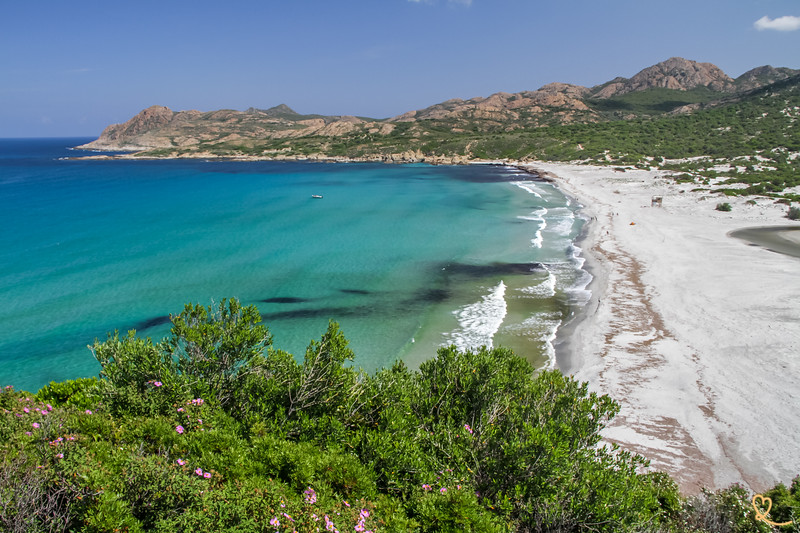
Where to stay

Best things to do in Bastia: other ideas
Ride on the U Spassimare
The U Spassimare is a soft path running along Bastia’s seafront, from the Toga marina in the north to the Arinella beach in the south. It passes by the Ficaghjola beach, the Aldilonda, the Quai des Martyrs in the old port, and Place Saint-Nicolas.
Benches and deckchairs line the route. Many Bastians take advantage of this road to play sports or simply stroll and enjoy the sunshine.

Other noteworthy churches
Bastia also boasts a number of other remarkable churches:
- Notre-Dame de Lourdes church:
On our way back up to the marina, we saw this large 20th-century church, whose original vault and stained glass windows were destroyed during the Second World War. Only the statue of the Virgin Mary above the choir, presented in a rock setting in reference to Lourdes, remains intact. While it lacks the splendor of Bastia’s other religious buildings, we think it may be worth a visit as Corsica’s only church dedicated to Notre-Dame de Lourdes.

- Saint-Charles-de-Borromée church:
This church is one of the oldest in Bastia. It was founded by the Jesuits in the mid-17th century. We liked its façade, inspired by that of Gesu in Rome. A statue of Saint Ignatius of Loyola can be seen in a niche beside the front door. In the 18th century, the Jesuits were expelled from the church, which was then dedicated to St. Charles de Borromeo. Unfortunately, the church is only open during religious services. But we advise you to go there because you’ll also see the façade of the Caraffa palace, a wealthy Bastia family. Historically, you’ll find yourself on what was the city’s main thoroughfare in the 17th and 18th centuries.

What to do in and around Bastia: sporting activities
Nautical activities
During your stay in Bastia, we recommend that you take advantage of the water sports. In addition to those available on the beaches of Arinella and Marana (jet-ski…), you’ll find diving clubs in the heart of Bastia’s marina.
We recommend that you embark on a cruise from Bastia’s old port. Here is our selection:
- Excursion to Cap-Corse: discover the Genoese towers of Miomo and Sacro, and the beaches of Lavasina and Erbalunga. Book your cruise now.
- Excursion to the tip of Cap-Corse: discover the Bay of Santa Maria, the Finocchiarola islands and the Giraglia island. Book your cruise now.
- Day trip to the island of Capraia: discover the 3rd largest island in the Tuscan archipelago, its old town, volcanic rocks and unspoilt beaches. Book your cruise now.

Flying activities
From Bastia airport, numerous air excursions are available, allowing you to discover the beautiful landscapes of the surrounding regions from a different angle.
Here are the ultralight flights available:
- Flight over Cap-Corse: fly over the villages of Nonza, Erbalunga and Pino, and heavenly beaches such as Pietracorbara. Check availability and book your flight. This tour is also available by gyrocopter (ULM 2-seater), click here to book your flight.
- Flight over the Gulf of Saint-Florent and the Agriates Desert: fly over the town of Saint-Florent and the beaches bordering the Agriates Desert (Lotu, Saleccia, Ghignu…) Check availability and book your flight .
- Private flight over the Monte Cinto region: over the mountain ranges and lakes of central Corsica (Monté Cinto, Paglia Orba and Capu Tafunatu). Check availability and book your flight.

Horseback riding
Bastia has a number of equestrian centers nearby. Here is our selection:
- Haras des Sables: 16min drive from Bastia, between the Bugliglia lake and the beach. Beach walks available. Find out more and contact the riding school via the official website.
- Cavallu di Brando: 18min drive north of Bastia. Several pony rides are available for beginners and even children. Find out more on the official website.
Subscribe to our Newsletter
- Get away from it all with Region Lovers’ beautiful destinations!
- Once a month
- Advertising-free
What to do around Bastia
Nearby beaches
To the south of Bastia, there are two great beaches: Arinella and Marana. Although touristy, these sandy beaches are still very pleasant, and offer a wide range of activities and facilities:
- Arinella Beach: sports fields, skatepark, ping-pong tables, playground, toilets, disabled access, showers, parking (car, bike, scooter), restaurants and snack bars, yacht club, jet-ski and towed-boat tours: find out more on the official Bastiajet website. Flying inflatable boat tours are also available on the official Corsica Aero website.
- Marana beach: racket sports fields, parking lot and sailing club (water sports equipment rental, courses and training: see official website for details).

Discover our article dedicated to Arinella beach to help you prepare for your visit.
Visit Galea Park
Parc Galea is a 40-minute drive from Bastia. We really recommend this visit, which is one of our favorites. The Galea park features landscaped gardens for visitors to discover the botanical species of Corsica and the Mediterranean. These include one of Europe’s finest collections of cacti, with no fewer than 300 species!

Along the way in the gardens, exhibition pavilions and museums are set up on the themes of Corsica’s cultural and natural heritage. Fun and accessible, for adults and children alike! A program of lectures and documentary screenings in the dedicated cinema brings the site to life.

Last but not least, a “barefoot” trail lets visitors take off their shoes and reconnect with nature on a playful journey that’s sure to delight young and old alike!
Galea Park is open:
Adult admission costs €9, with children’s tickets priced at €6 (7/18 years) and €4 (4/6 years). Children up to the age of 3 are free.
- daily from 2 pm to 6 pm from April 17 to June 30 and from September 1 to 30.
- daily from 10 am to 6 pm from July 1 to August 31.
- Sundays from 12pm to 6pm from March 12 to April 16 and from October 1 to 29.

Discover our article dedicated to the Galea park to help you prepare your visit.
Visit the archaeological site of Mariana
A 30-minute drive from Bastia, you can discover the Mariana Museum and its archaeological site. Inaugurated in 2021, this museum houses an archaeological collection enabling visitors to learn more about Corsica, the way of life of the first inhabitants of the town of Mariana and their links with other Mediterranean peoples.
The remains of this ancient, early Christian and medieval town can be seen right next to the museum. Don’t miss the 12th-century Canonica Cathedral, still in use today.

A self-guided tour of the museum costs €7, with a reduced rate of €4 and free admission for children under 8.
The museum is open daily from 10am to 7pm, except Mondays.
Find out more in our next article dedicated to the Mariana museum and archaeological site.
Biguglia pond and nature reserve
A 15-minute drive south of Bastia, you can take a stroll in the Etang de Biguglia nature reserve. This protected natural site in the commune of Furiani borders the Marana beach. This area is the wettest in Corsica and therefore home to numerous birds and a rich flora. However, the site is difficult to access out of season. We advise you to enjoy the views of the pond from your car, or by bike along the main road.

Admire Lake Padula
Lake Padula can be reached by car in 45 minutes from Bastia. We recommend a stopover if you’re on your way to Saint-Florent, for example. The views of this man-made lake and the surrounding mountains are truly breathtaking. You’ll also have the chance to admire the pretty village of Oletta, overlooking the lake.

Visit the surrounding villages
Are you staying in Bastia for a few days? If you have time, you can visit the villages around the capital of Haute-Corse:
- Village of Vescovato: 40 minutes south of Bastia, this typically Corsican hilltop village is a delight to explore. Streams and covered passageways wind their way through traditional houses.
- Village of Furiani: 10min south of Bastia by car, home to the Genoese Paoline tower, remnant of an ancient medieval castle. From the castle, you can take a 1-hour walk to reach a small Romanesque chapel and enjoy a beautiful view of the Marana lido and Biguglia lake.
- Balcony villages of Santa Maria di Lota and San Martino di Lota: 20 minutes from Bastia, these villages are the starting point for numerous hikes. They include numerous religious buildings and are characterized by their farmland.
- Balcony villages of Ville-di-Pietrabugno and Cardo: just 10 minutes from Bastia, you’ll find numerous hiking trails. Ville-di-Pietrabugno is home to the imposing church of Sainte-Lucie, and Cardo to 16th- and 18th-century icehouses.

OUR TIPS FOR RENTING A CAR IN Corsica
- Compare prices on our preferred platform: DiscoverCars – one of the best rated sites.
- Choose a car that is powerful enough (the roads are steep) but compact (some passages are narrow).
- Think of thecomplete insurance (some roads are tortuous and narrow).
- There is a lot of demand, book it early.

Useful tips: Bastia, Corsica, France
Where is Bastia?
Bastia is located in the north of Corsica, in the Haute-Corse department.
How to get there
Bastia is served by regular national flights from Paris, Nice and Marseille. It’s also Corsica’s biggest port, along with Ajaccio, so you can opt for the ferry to get there. To choose the best solution, consult our dedicated article on the subject.

Tips for visiting Bastia
To visit Bastia, we recommend you wear good shoes! Indeed, the climbs up to the citadel are quite steep. If you come to Bastia from spring to autumn, a cap and sunglasses will be more than useful, especially in the exposed citadel area or on Place Saint-Nicolas.

Getting around Bastia and the surrounding area
The easiest way to visit Bastia’s surroundings is by car. In the urban area, most parking lots are free of charge, but not in the city center, where you’ll find a large number of pay-and-display underground parking lots.
The most pleasant way to visit Bastia is on foot. The town is on a human scale, and everything is within easy walking distance. It’s also the best way to meander through the city’s narrow streets!
Bicycles are also available for hire, enabling you to ride to the beaches south of Bastia, for example. For more information, visit the official website of Cycles 20, a 13-minute walk from Place Saint-Nicolas.
Bastia boasts a significant bus network, with numerous lines linking the city center to the rest of the conurbation. Find out more on the official website.

Where to stay in Bastia?
In Bastia, you’ll find numerous hotels in the city center, generally rated 2 or 3 stars. Here’s a selection to guide you:
- Hôtel des Gouverneurs (4 stars): a sophisticated hotel in the citadel district, offering stunning sea views, a panoramic terrace, bar and cosy lounge. Prices, photos and availability. Look out for our dedicated article very soon.
- Hôtel Monsieur Miot (3 stars): a concept hotel in an apartment building with modern, ergonomic rooms, whose reception is located in the center café. Prices, photos and availability. Look out for our dedicated article very soon.
- Hotel Alivi: a little further from the town center but with sea and beach views. Prices, photos and availability.
See our article on the best hotels in Bastia.

Where to eat in Bastia
A wide choice of restaurants is available in Bastia. Dishes are generally hearty, and local produce is given pride of place. Here’s our selection of restaurants in Bastia:
- Le Café des Gourmets: a downtown restaurant offering healthy cuisine (poke bowls, salads, tartines…) and a breakfast and brunch menu (sweet and savoury pancakes, cookies…). Our dedicated article will be available shortly.
- La Table de Mare & Gusto: a restaurant on the market square, offering refined Corsican and Italian cuisine. You’ll also find tapas and a store selling local produce. Our dedicated article will be available shortly.
- Le Nova: a restaurant with a pleasant terrace, near Boulevard Paoli. The à la carte menu features tapas, salads, pastas and risottos, as well as a wide choice of cocktails. Our dedicated article will be available shortly.

Visit Bastia in 1 day
If you’re visiting Bastia and only have a day to spare? See below for our selection of must-sees.
- Start by strolling through Place Saint-Nicolas.
- Then take rue Napoléon. Visit the Saint-Roch Oratory.
- Continue down the street and buy Corsican products at U Paese.
- Visit the Oratory of the Immaculate Conception.
- Take the “ruelle de la création” and you’ll find yourself in the market square.
- Visit Saint-Jean-Baptiste Church.
- Time for lunch? Take a break on the terrace of Table Mare & Gusto.
- Resume your tour of Bastia by taking rue Cardinal Viale Prelà, then rue Saint-Jean, and take the alley to the left of the A Scaletta restaurant to visit the old port.
- Walk along the quays of the old port to the Romieu garden and visit it. Leaving the Romieu garden, walk up the Favale crossroads to the citadel.
- Enter the citadel and stroll down Rue Notre-Dame to Cathédrale Sainte-Marie.
- After your visit to the cathedral, retrace your steps to finish the day with a visit to the Governors’ Palace.

Visit Bastia in 2 days
Bastia is a city that can be visited in a weekend. See below for our visit tips:
Day 1:
- Start by strolling through Place Saint-Nicolas.
- Head back towards the marina: why not take advantage of Toga beach if the weather’s fine?
- Retrace your steps and take a look at the Notre-Dame de Lourdes church.
- Stroll around Place Saint-Nicolas.
- Then take boulevard Paoli. Time for lunch? Eat at the Nova restaurant.
- Take rue Font-Neuve to stroll down rue Napoléon. Visit the Oratory of the Immaculate Conception .
- Continue down the street and buy Corsican products at U Paese.
- Visit the Saint-Roch Oratory.
- Take the “ruelle de la création” and you’ll find yourself in the market square.
- Visit Saint-Jean-Baptiste Church.
- Resume your tour of Bastia by taking rue Cardinal Viale Prelà, then rue Saint-Jean, and take the alley to the left of the A Scaletta restaurant to visit the old port.
- Head up Via Vattelapesca to take a look at the Church of St. Charles Borromeo.
- Time for dinner? Return to the old port. Why not dine at Table Mare & Gusto in the market square?
Day 2:
- Walk along the quays of the old port to the Romieu garden and visit it. Leaving the Romieu garden, walk up the Favale crossroads to the citadel.
- Enter the citadel and stroll down Rue Notre-Dame to Cathédrale Sainte-Marie.
- After your visit to the cathedral, retrace your steps and visit the Governors’ Palace.
- Lose yourself in the citadel and dine in one of its many restaurants.
- Take a look at the frescoes in the U Cimbalu house.
- Take a 20-minute walk to the Scala Santa and visit it.
- Descend from the heights of Bastia to reach the Ficaghjola beach.
- After enjoying the beach, take the U Spassimare back to the old port and admire the view from the Aldilonda .
- Dinner on the old port or at the Café des gourmets.

Visit Bastia in 3 days
Are you staying in Bastia for a 3rd day? Take advantage of the opportunity to go on an excursion or visit Bastia’s surroundings. Here is our selection:
- Option 1: Go to Parc Galea, then eat at Les Sens restaurant. In the afternoon, visit the archaeological site of Mariana, and enjoy the Arinella beach. On the way back to Bastia, take a look at the Biguglia pond.
- Option 2: Visit Galea Park in the morning and take a cruise to Cap-Corse in the afternoon.
- Option 3: Take a 4WD day trip to the Agriates desert, or take your own car and visit Cap-Corse, Balagne, or Saint-Florent and its gulf.

Frequently asked questions
What to do in Bastia when it rains?
A wide choice of activities is available if it rains during your stay in Bastia.
Cultural activities:
- Go to the cinema: Le Régent or Le Studio.
- Visit religious buildings: Oratoire Saint-Roch, Église Saint-Jean-Baptiste, cathedral…
- Visit the Palais des Gouverneurs – Museum of Bastia.
- Go to the municipal theater.
Fun activities:
- Escape Game Scappa 23min drive south of Bastia.
- Factory zones (laser games, arcade room and board games) in Furiani (15min south of Bastia by car).
- Furiani bowling alley (laser gun and billiards) 20min drive from Bastia.

Bastia or Ajaccio: which to choose?
Having trouble deciding between the capital of southern Corsica and that of northern Corsica? It all depends on what you’re looking for. The two cities are very different. For access to beaches and museums, choose Ajaccio, and for the city’s beauty, atmosphere and religious buildings, choose Bastia. To find out more, read our dedicated article.

What to do in Bastia with your family
Here are some ideas for visiting Bastia with your family:
- Take the little tourist train tour: departing from the tourist office, you’ll see Bastia’s must-sees in a fun way that won’t tire out the little ones. Find out more on the official website.
- Enjoy the Arinella beach: children will love its playground and water activities.
- Family Parc: a 20-minute drive south of Bastia, this leisure park is specially designed for families. You’ll find a mini-accrobranche, a zip line, as well as activities and games for children, teenagers and adults. Find out more on the official website.
- Go to the Western Splash aquatic center: right next to the Family Parc, your children will find what they’re looking for (wave pools, slides…). Find out more on the official website.
- Corsica Zoo: a 45-minute drive from Bastia, this 8-hectare park is home to over 400 animals of around 60 different species. Find out more on the official website.

Which campsites are close to Bastia?
There are a number of campsites to the north and south of Bastia. Here is our selection:
- Les Sables Rouges: the closest campsite to Bastia (8 minutes by car), very close to the Arinella beach.
- Camping San Damiano (4 stars): campsite located between the Etang de Biguglia and the beach, with swimming pool, playground, entertainment and supermarket.
All our tips in this article were put into words with the help of Fanny.

